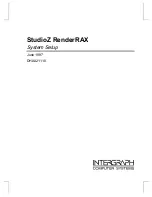
Document # 001-20559 Rev. *D
39
Sleep and Watchdog
12.4.2
Wake Up Sequence
Once asleep, the only event that can wake the system up is
an interrupt. The Global Interrupt Enable of the CPU flag
register does not need to be set. Any unmasked interrupt
wakes the system up. It is optional for the CPU to actually
take the interrupt after the wake up sequence.
The wake up sequence is synchronized to the 32 kHz clock
for purposes of sequencing a startup delay, to allow the
Flash memory module enough time to power up before the
CPU asserts the first read access. Another reason for the
delay is to allow the IMO, bandgap, and LVD/POR circuits
time to settle before actually being used in the system. As
shown in
, the wake up sequence is as follows.
1. The wake up interrupt occurs and is synchronized by the
negative edge of the 32 kHz clock.
2. At the following positive edge of the 32 kHz clock, the
system-wide PD signal is negated. The Flash memory
module, IMO, and bandgap any POR/LVD circuits are all
powered up to a normal operating state.
3. At the next positive edge of the 32 kHz clock, the values
of the bandgap are settled and sampled.
4. At the following negative edge of the 32 kHz clock (after
about 15
s, nominal) the values of the POR/LVD sig-
nals have settled and are sampled. The BRQ signal is
negated by the sleep logic circuit. On the following CPU
clock, BRA is negated by the CPU and instruction exe-
cution resumes.
The wake up times (interrupt to CPU operational) range
from two to three 32 kHz cycles or 61 - 92
s (nominal).
Figure 12-2. Wake Up Sequence
CLK32K
INT
SLEEP
PD
CPUCLK/
24 Mhz
BRQ
BRA
CPU
Sleep timer or GPIO
interrupt occurs.
CPU is restarted after
75
s (nominal).
(Not to Scale)
BANDGAP
LVD/PPOR
ENABLE
POR/LVD/
BANDGAP
SAMPLE
BANDGAP
Interrupt is double sampled by
32K clock and PD is negated to
system.
SAMPLE
LVD/POR
LVD/PPOR is valid
Summary of Contents for PSoC CY8C23533
Page 4: ...Contents Overview 4 Document 001 20559 Rev D Section G Glossary 385 Index 401 ...
Page 16: ...Contents Overview 16 Document 001 20559 Rev D ...
Page 24: ...24 Document 001 20559 Rev D Section A Overview ...
Page 30: ...30 Document 001 20559 Rev D Pin Information ...
Page 54: ...54 Document 001 20559 Rev D Supervisory ROM SROM ...
Page 60: ...60 Document 001 20559 Rev D RAM Paging ...
Page 68: ...68 Document 001 20559 Rev D Interrupt Controller ...
Page 76: ...12 Document 001 20559 Rev D General Purpose IO GPIO ...
Page 82: ...18 Document 001 20559 Rev D Internal Main Oscillator IMO ...
Page 84: ...20 Document 001 20559 Rev D Internal Low Speed Oscillator ILO ...
Page 90: ...26 Document 001 20559 Rev D External Crystal Oscillator ECO ...
Page 94: ...30 Document 001 20559 Rev D Phase Locked Loop PLL ...
Page 106: ...42 Document 001 20559 Rev D Sleep and Watchdog ...
Page 228: ...164 Document 001 20559 Rev D Section D Digital System ...
Page 234: ...170 Document 001 20559 Rev D Array Digital Interconnect ADI ...
Page 278: ...214 Document 001 20559 Rev D Digital Blocks ...
Page 296: ...232 Document 001 20559 Rev D Analog Interface ...
Page 304: ...240 Document 001 20559 Rev D Analog Array ...
Page 308: ...244 Document 001 20559 Rev D Analog Input Configuration ...
Page 312: ...248 Document 001 20559 Rev D Analog Reference ...
Page 338: ...274 Document 001 20559 Rev D Section F System Resources ...
Page 354: ...290 Document 001 20559 Rev D Multiply Accumulate MAC ...
Page 374: ...310 Document 001 20559 Rev D I2C ...
Page 400: ...336 Document 001 20559 Rev D Section G Glossary ...









































